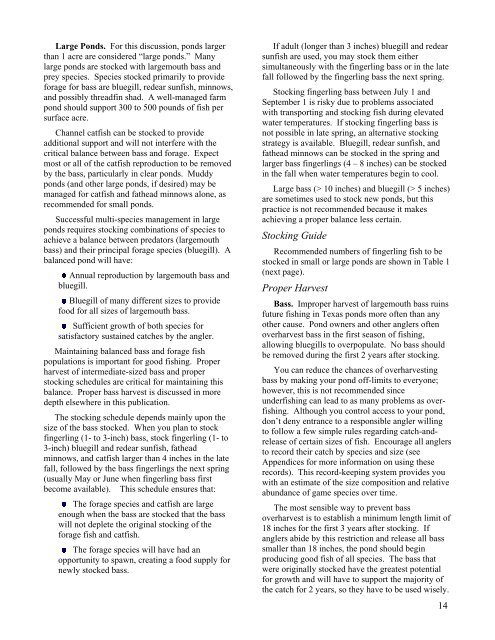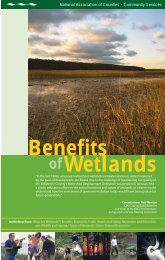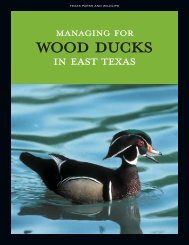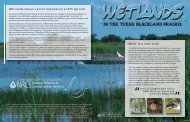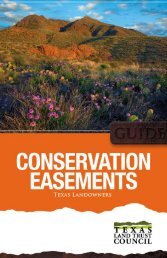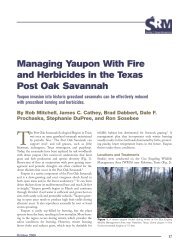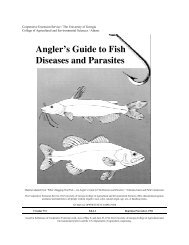Texas Farm Ponds: Stocking, Assessment, and Management ...
Texas Farm Ponds: Stocking, Assessment, and Management ...
Texas Farm Ponds: Stocking, Assessment, and Management ...
Create successful ePaper yourself
Turn your PDF publications into a flip-book with our unique Google optimized e-Paper software.
Large <strong>Ponds</strong>. For this discussion, ponds larger<br />
than 1 acre are considered “large ponds.” Many<br />
large ponds are stocked with largemouth bass <strong>and</strong><br />
prey species. Species stocked primarily to provide<br />
forage for bass are bluegill, redear sunfish, minnows,<br />
<strong>and</strong> possibly threadfin shad. A well-managed farm<br />
pond should support 300 to 500 pounds of fish per<br />
surface acre.<br />
Channel catfish can be stocked to provide<br />
additional support <strong>and</strong> will not interfere with the<br />
critical balance between bass <strong>and</strong> forage. Expect<br />
most or all of the catfish reproduction to be removed<br />
by the bass, particularly in clear ponds. Muddy<br />
ponds (<strong>and</strong> other large ponds, if desired) may be<br />
managed for catfish <strong>and</strong> fathead minnows alone, as<br />
recommended for small ponds.<br />
Successful multi-species management in large<br />
ponds requires stocking combinations of species to<br />
achieve a balance between predators (largemouth<br />
bass) <strong>and</strong> their principal forage species (bluegill). A<br />
balanced pond will have:<br />
Annual reproduction by largemouth bass <strong>and</strong><br />
bluegill.<br />
Bluegill of many different sizes to provide<br />
food for all sizes of largemouth bass.<br />
Sufficient growth of both species for<br />
satisfactory sustained catches by the angler.<br />
Maintaining balanced bass <strong>and</strong> forage fish<br />
populations is important for good fishing. Proper<br />
harvest of intermediate-sized bass <strong>and</strong> proper<br />
stocking schedules are critical for maintaining this<br />
balance. Proper bass harvest is discussed in more<br />
depth elsewhere in this publication.<br />
The stocking schedule depends mainly upon the<br />
size of the bass stocked. When you plan to stock<br />
fingerling (1- to 3-inch) bass, stock fingerling (1- to<br />
3-inch) bluegill <strong>and</strong> redear sunfish, fathead<br />
minnows, <strong>and</strong> catfish larger than 4 inches in the late<br />
fall, followed by the bass fingerlings the next spring<br />
(usually May or June when fingerling bass first<br />
become available). This schedule ensures that:<br />
The forage species <strong>and</strong> catfish are large<br />
enough when the bass are stocked that the bass<br />
will not deplete the original stocking of the<br />
forage fish <strong>and</strong> catfish.<br />
The forage species will have had an<br />
opportunity to spawn, creating a food supply for<br />
newly stocked bass.<br />
If adult (longer than 3 inches) bluegill <strong>and</strong> redear<br />
sunfish are used, you may stock them either<br />
simultaneously with the fingerling bass or in the late<br />
fall followed by the fingerling bass the next spring.<br />
<strong>Stocking</strong> fingerling bass between July 1 <strong>and</strong><br />
September 1 is risky due to problems associated<br />
with transporting <strong>and</strong> stocking fish during elevated<br />
water temperatures. If stocking fingerling bass is<br />
not possible in late spring, an alternative stocking<br />
strategy is available. Bluegill, redear sunfish, <strong>and</strong><br />
fathead minnows can be stocked in the spring <strong>and</strong><br />
larger bass fingerlings (4 – 8 inches) can be stocked<br />
in the fall when water temperatures begin to cool.<br />
Large bass (> 10 inches) <strong>and</strong> bluegill (> 5 inches)<br />
are sometimes used to stock new ponds, but this<br />
practice is not recommended because it makes<br />
achieving a proper balance less certain.<br />
<strong>Stocking</strong> Guide<br />
Recommended numbers of fingerling fish to be<br />
stocked in small or large ponds are shown in Table 1<br />
(next page).<br />
Proper Harvest<br />
Bass. Improper harvest of largemouth bass ruins<br />
future fishing in <strong>Texas</strong> ponds more often than any<br />
other cause. Pond owners <strong>and</strong> other anglers often<br />
overharvest bass in the first season of fishing,<br />
allowing bluegills to overpopulate. No bass should<br />
be removed during the first 2 years after stocking.<br />
You can reduce the chances of overharvesting<br />
bass by making your pond off-limits to everyone;<br />
however, this is not recommended since<br />
underfishing can lead to as many problems as overfishing.<br />
Although you control access to your pond,<br />
don’t deny entrance to a responsible angler willing<br />
to follow a few simple rules regarding catch-<strong>and</strong>release<br />
of certain sizes of fish. Encourage all anglers<br />
to record their catch by species <strong>and</strong> size (see<br />
Appendices for more information on using these<br />
records). This record-keeping system provides you<br />
with an estimate of the size composition <strong>and</strong> relative<br />
abundance of game species over time.<br />
The most sensible way to prevent bass<br />
overharvest is to establish a minimum length limit of<br />
18 inches for the first 3 years after stocking. If<br />
anglers abide by this restriction <strong>and</strong> release all bass<br />
smaller than 18 inches, the pond should begin<br />
producing good fish of all species. The bass that<br />
were originally stocked have the greatest potential<br />
for growth <strong>and</strong> will have to support the majority of<br />
the catch for 2 years, so they have to be used wisely.<br />
14


